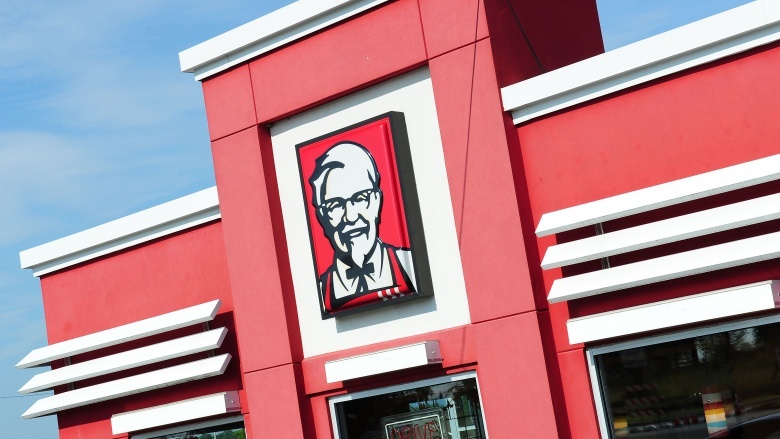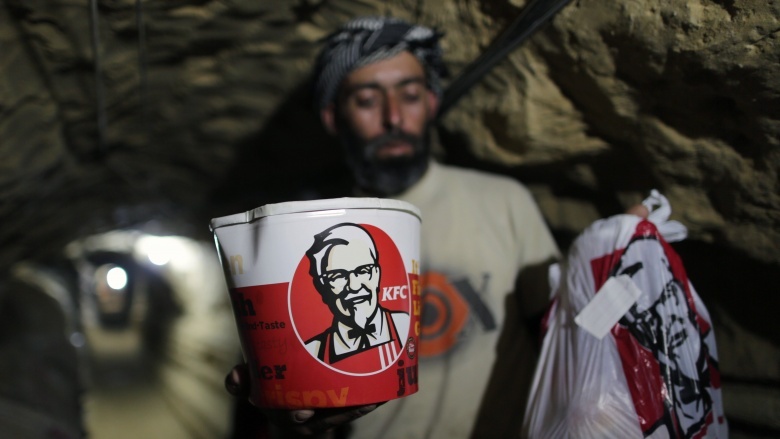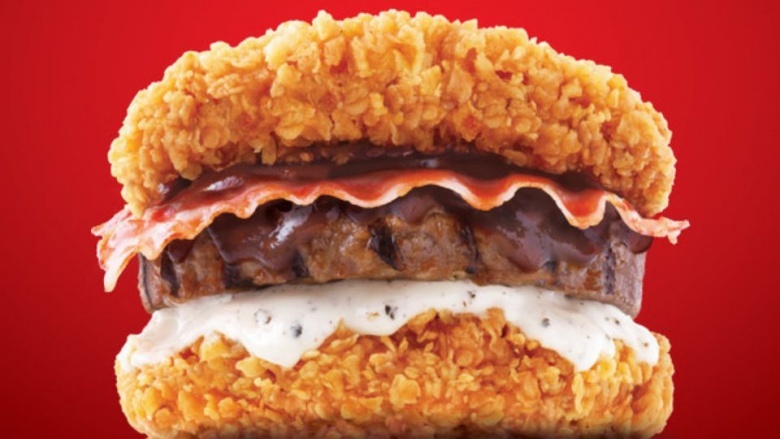9 Ways KFC Is Completely Different In Other Countries
Kentucky Fried Chicken (now better known as KFC) has come a long way from its humble origins inside a simple gas station in North Corbin, Kentucky. It is now one of the largest, best-known fast food franchises in the world, with over 18,000 branches in 115 countries, and you'd be hard-pressed to find someone who doesn't recognize the white hair and matching suit of Colonel Sanders. While the decidedly tasty chicken has played a part in that success (and who can forget the mashed potatoes, gravy, and biscuits?), the company has also learned to adapt to each new market, evolving in some pretty unexpected ways. Once you leave the United States, you might from something completely different than your beloved coleslaw if you walk inside. Here are some ways KFC around the world might be very different from what you probably expected.
China
KFC got off to a rough start in the Chinese market when it translated "finger-lickin' good" into Chinese characters meaning "eat your fingers off." The company rallied, and KFC China has since expanded rapidly by abandoning the American market model of a limited and cheap menu emphasizing takeout and instead reflecting China's strong restaurant dining culture.
KFC restaurants in China have much larger eating areas to accommodate large families and groups. The kitchens are also larger to allow for more extensive and localized menu items, such as rice dishes, soy milk drinks, egg tarts, and youtiao fried dough sticks. Unpopular Western side dishes like coleslaw and mashed potato are often replaced with more palatable fare, such as a salad of shredded carrot, fungus, and bamboo shoots.
KFC China caters to novelty-seeking local consumers by introducing over 50 new or limited time-only items per year, compared to one or two such items on American KFC menus. They are also sensitive to regional differences in taste, so KFC spicy chicken is much hotter in Sichuan than in Shanghai.
KFC doesn't bother to compete on price with the ubiquitous street vendors and cheap local restaurants in China. It has instead positioned itself as a mid-range meal option for young professionals or a rare treat for families. With a focus on high standards of service, they employ over twice as many people as their U.S. counterparts, including hostesses who greet patrons and organize activities for children.
In the western province of Xinjiang, which has a large population of Muslim Uighurs with their own traditions, one KFC branch took an unusual step for attracting local customers. Ad posters in Urumqi touted KFC as the perfect venue for a traditional circumcision party, featuring a host, singing, dancing, games, gift packs, and the presence of the local KFC mascot, Chi Chi.
India
KFC's first attempt to expand into the Indian market floundered in the 1990s, so after relaunching in 2004, KFC India adopted a novel strategy to attract local customers by expanding their vegetarian menu options in 2012. Items such as the Veg Zinger, Paneer Zinger, Potato Krisper Burger, and Hot Veg Snacker aimed to snare India's sizable vegetarian market and entice non-vegetarians with their wide variety. Up to 42 percent of Indian households are vegetarian.
In 2016, the company fell back on a chicken-centric strategy and opted to promote their new chicken items while abandoning the marketing for their vegetarian items. But the menu hasn't changed much, which are still 30 percent vegetarian.
KFC India has also moved to take advantage of India's highly wired population. In 2016, they introduced the Watt-A-Box, packages of chicken or burgers with built-in mobile phone chargers, hoping to entice some of the 220 million Indian smartphone users. They have also signed up with Indian Railway's e-catering service, which allows travelers to use their cellphones to order buckets of chicken to tide them over on long train journeys. After the Indian state of Karnataka passed legislation against non-essential plastics like disposable plates and cutlery, KFC branches in Bengaluru began trying out edible tortilla bowls for their Rice Bowlz menu. The long term hope is these edible bowls will be expanded to KFCs throughout the country.
Russia
The KFC Russia menu is largely familiar to Americans with a couple of quirks, such as oatmeal on the breakfast menu and draft beer on the drinks menu. Another unexpected item is the teriyaki rice bowl, the last vestige of a successful 2014 promotion of teriyaki menu options, some including disposable chopsticks to add to the Japanese feel. There were even chicken burgers and wraps served with gari, the pickled ginger slices usually used as a palate cleanser when eating sushi.
KFC Russia has a striking approach to digital marketing, relying heavily on viral media. In 2011, they gave away 100,000 free sandwiches to those who joined the official KFC page on VKontakte, the popular Russian social media site. Then in 2014 they recruited the creative agency Hungry Boys to create a viral video in which a university student throws chicken at his teacher in the lecture hall, until the lecturer gets so annoyed he approaches the student and upends the bucket on the kid's head. The resulting "Bucket Head" meme and viral video trend paid off for KFC in a country where most young people don't watch TV or pay attention to advertising.
Nigeria
Although KFC is expanding rapidly in several African countries, it has run into some unexpected challenges in Nigeria where importing chickens is banned and local sources are sometimes unreliable. Relative poverty for much of the population makes further expansion difficult, although KFC has been able to attract many patrons thanks to Wi-Fi and reliable air conditioning. They have adapted parts of the menu to suit local tastes, including vegetarian options and serving spicy jollof rice.
In 2014, KFC Nigeria launched a campaign on Facebook and Twitter to promote the Big Boss burger, a short-lived attempt to sell a fried chicken patty version of McDonald's Big Mac. Patrons at KFC stores in Nigeria were challenged to finish the burger in under 60 seconds. It's pretty unrealistic when you see the size of the burger, and you have to think anyone who succeeded would have trouble keeping it down.
The Philippines
In the Philippines, KFC must contend with a strong rival, local franchise Jollibee's, which serves plenty of fried chicken, as well as burgers, spaghetti, and Filipino favorites like lumpia (meat-filled egg rolls) and bangus (milkfish). Against such a formidable foe, KFC Philippines seems to have opted for a strategy of culinary creativity.
KFC Philippines has a number of menu items that will either absolutely horrify you or that will make your mouth water. Maybe both. In 2015, they did a promotion on the Double Down Dog, a cheese-filled hot dog smothered in more cheese and set in a "bun" made of a fried chicken patty. They quickly sold out, despite some on Twitter accusing the franchise of crimes against humanity. They introduced the Chizza that same year, basically a large slice of chicken covered in pizza sauce, cheese, green peppers, and pineapple. While its status as pizza is dubious, it isn't so much different from chicken parmigiana.
Another KFC Philippines menu item which mystified foreigners was the Cheese Top burger, featuring a slice of cheese draped over the top of the bun rather than inside it. What seems bizarre to others makes sense for Filipinos familiar with the ensaymada, a sweet bun topped with shredded Edam cheese.
They took this to the extreme in 2013 with the Cheesy Bacon Fest, a promotion which allowed consumers to add cheese and bacon topping to almost everything on the menu, sadly excluding single pieces of chicken, salads, and desserts.
Israel
In 2009, KFC Israel hoped to attract more business by adhering to Jewish religious dietary laws. KFC chicken is traditionally coated with milk powder, violating rules against mixing meat with dairy. KFC Israel developed a milk-flavored soy powder to be used as a kosher substitute. Approved by KFC food scientists in Dallas, Texas, it allegedly had the same flavor as the original chicken. Despite these efforts, KFC Israel ceased operations in 2013, but fans of the franchise still hold hope it will return.
KFC has had far more success in the Palestinian territories. In the 1990s, attempts by the Palestinian Authority to attract American franchises failed, and Israeli KFC franchise owners demanded the Palestinians apply for the franchise through Israel. However, entrepreneur Adeeb Bakri went straight to the mother company asking for the franchise and opened his first KFC in Ramallah to high demand. KFC Palestine now has six branches in the West Bank.
It's not as easy for the Palestinians in the isolated Gaza strip, but the Colonel finds a way. Ordering KFC in Gaza requires making an international telephone order and wire transfer, then waiting for an Egyptian taxi driver to pick it up from a KFC in the Sinai, who hands it over to a courier who smuggles it into Gaza through underground tunnels, who hands it over to a Gazan taxi driver who drives it to a local KFC entrepreneur, who then delivers it to you via motorcycle courier. Twelve pieces of cold chicken and fries costs $27, but the demand is still high enough for the KFC brokers to make a healthy profit.
South Korea
KFC faces stiff competition in South Korea, which has an extremely well developed fried chicken restaurant industry of its own. One hit was the notorious Double Down, which proved popular enough to become a common menu item and spawn several monstrous offspring. The 2013 Zinger Double Down Maxx featured bacon, cheese, and a hash brown between two chicken buns, and in 2014 they introduced the Zinger Double Down King: bacon, BBQ sauce, white pepper sauce and a beef patty between two spicy chicken fillets.
Of course, KFC Korea also made some efforts at localizing the menu that didn't require the deaths of all the local livestock. This includes sides and desserts like fried ice cream and mozza balls (fried bread balls filled with mozzarella, coming in plain or squid ink black varieties). More recently, KFC Korea has thrown its hat in the ring of "chimaek," the popular South Korean combination of fried chicken and draft beer.
Azerbaijan
Azerbaijani KFC has a menu which is recognizable, if somewhat limited. They do win style points for their description of their wings: "Fire inside! Far from angels' wings!" What makes Azerbaijan interesting is the KFC built inside a Soviet railway station, one of the largest KFC restaurants in the world.
The Sabunchu rail station was built in 1926 by the Soviet Union to service the railway tracks between Baku and nearby petroleum-producing regions. The imposing Moorish-style building has fallen into disrepair until it was bought by local KFC franchise partner AFK Ltd. After over 3 million euros were spent on renovation, the restaurant opened in 2012 with a floor plan of 1,600 square meters, seating for 300 people, and bold plans to serve over 1.5 million meals per year.
Sadly for Azerbaijan, they lost the title of world's largest KFC restaurant to the Ukraine in 2013. The KFC located at the National Railway Station's south terminal in Kiev is 1,700 square meters and is able to serve 280 people in the dining room, 400 on the patio, and 200 cars an hour through its double drive-thru lanes. Yet it still somehow lacks the charm of the twin-domed edifice in Baku.
Japan
KFC in Japan reflects the local preference for dark meat over white meat, and serves rice bowls and bento boxes familiar to Japanese consumers. It is however far more expensive than in the U.S., which is partially made up for by the fact the workers receive extensive culinary and service training, and you can get your chicken delivered straight to your door. Omnipresent images of the Colonel have the flavor of a benign personality cult, reflected in distinctive server uniforms and friendly mascots wandering the stores.
KFC Japan is no slouch when it comes to marketing. During the summer at select locations, they offer a frankly dangerous all-you-can-eat chicken promotion. They once launched a Twitter promotion giving away keyboards, computer mouses, and USB sticks shaped like fried chicken.
On the other hand, KFC Japan sometimes opts for a more distinguished approach. In 2013, they introduced the sadly discontinued Colonel's Dish line, featuring apple wood-smoked chicken thighs, chicken terrine (upscale pate), and ballotine (chicken roasted with apricots, plums, cranberries, orange, and white wine-soaked chestnuts). They once even operated Route 25, the world's only KFC with a high-end whiskey bar.
One of the most striking things about KFC Japan is its popularity on Christmas. This tradition dates back to the extremely popular "Kurisumasu ni wa kentakkii!" ("Kentucky for Christmas!") marketing campaign of 1974. According to legend, KFC Japan's ad executives were inspired by a group of foreigners who couldn't find turkey for Christmas dinner and opted for the Colonel's chicken instead. Today, the KFC Christmas meal featuring chicken, wine, cake, and champagne is so popular that lines stretch out the doors and you'll need a reservation for your chicken bucket.


